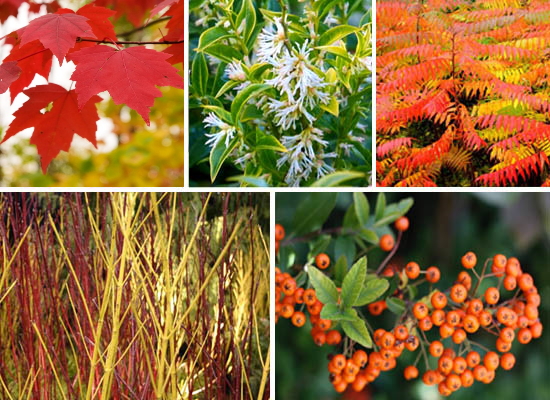November in the Garden (What to Do)
The evenings really draw in over the first 2 weeks of November and this gives us all less time in the garden as any free time with hours of daylight is now confined to the weekends. The weather too takes a turn for the worse and with that, the last of our hardy late Summer flowering plants fade away.
While all this cold and frosty weather can be a nuisance, it still certainly makes for some beautiful clear blue mornings, some wonderful foggy evenings and also the picturesque scenes of a frosty landscape – hard to beat.
Best Plants for the Month of November

(From left to right) Euonymus Europaeus, Sarcococca humilis, Rhus Typhina, Red & Yellow Dogwood, Pyracantha
Things to Consider
Preparations for Winter is top priority now. With the chance of prolonged cold weather over the coming months, all vegetables plants should be covered up, all tender bulbs dug up and stored indoors and all tender plants covered up with fleece.
November generally offers few days of good gardening so it is certainly not a time for resting on our laurels. The briefest moment of clement weather should be seized upon to stay on top of those essential tasks.
Sensible attire can make all the difference when gardening in the Winter months. It can be hard to convince oneself to get out there and start work. But with a cosy hat and pre-warmed socks it won’t take long to get back out amongst it.
Things to Do
In the Fruit & Veg Garden
- Turnips, beetroot, swedes, leeks, winter cabbage, brussel sprouts, kale, hardy carrot varieties and parsnips can all stay in the ground in November and be harvested as required
- Support top heavy Brussel Sprouts to protect from wind damage
- By this point all other vegetables should be harvested
- You can sow broad beans and peas directly outdoors in the month of November. A good variety to choose would be the broad bean Aguadulce and Pea Douce Provence
- If the weather is suitably dry you can start preparing your vegetable garden for next Spring. Dig over, add manure and allow to settle over the Winter months
- November is a good month for sowing garlic cloves
- Cover over rows with frost fleece mini tunnels, keeping the ends open for good ventilation
- Set up a windblock or screen around your vegetable plot over the Winter months
In the Greenhouse
- Ensure all screws and bolts are well tightened coming into the Winter months. With increased wind speeds greenhouses are more susceptible to damage
- Smaller greenhouses will need to be well anchored in the ground to avoid them falling over in strong winds
- Clean out all unused pots and trays to prevent the spread of fungus and bacteria into next season's crops
- Use a paraffin heater and insulation to keep greenhouse frost free over the Winter
Plant Care
- Hardwood cuttings can be taken in November. Choose 1 or 2 year old stems of woody plants to make good cuttings
- Continue to sow your Spring bulbs such as daffodils, tulips & snowdrops
- Mulch up around the base of all tender plants to keep them insulated over the Winter months. Plants such as phormiums, fatsia, yuccas, tree ferns and choisya are all susceptible to frost and will require protection
- Use frost fleece blankets to cover and insulate your most tender and treasured plants
- Continue to plant bareroot hedging over the month. This work can continue all Winter so long as the ground is not frozen
- You can also plant a range of other plants including bare root roses and a whole host of other containerised plants
Lawn Care
- Keep off your lawn in wet and frosty conditions
- Still time to aerate your lawn so long as conditions remain suitably dry
- Don’t allow leaves to build up on lawns to prevent bare patches on your lawn
General Maintenance
- When leaves have faded on young beech hedging plants you can spray the soil underneath them to kill weeds
- Continue to feed your wild garden birds with a mixture of feeds from sunflower seeds to fat balls or suet feeds
- Now is a good time to review your garden and decide what to plant and what improvements can be made over the coming year
- As you put away your garden tools for the Winter months be sure to give them some much needed TLC by cleaning, oiling, sanding & sharpening as required
- Continue to rake up fallen leaves and create a leaf mulch compost area for rich humus compost for next Summer











